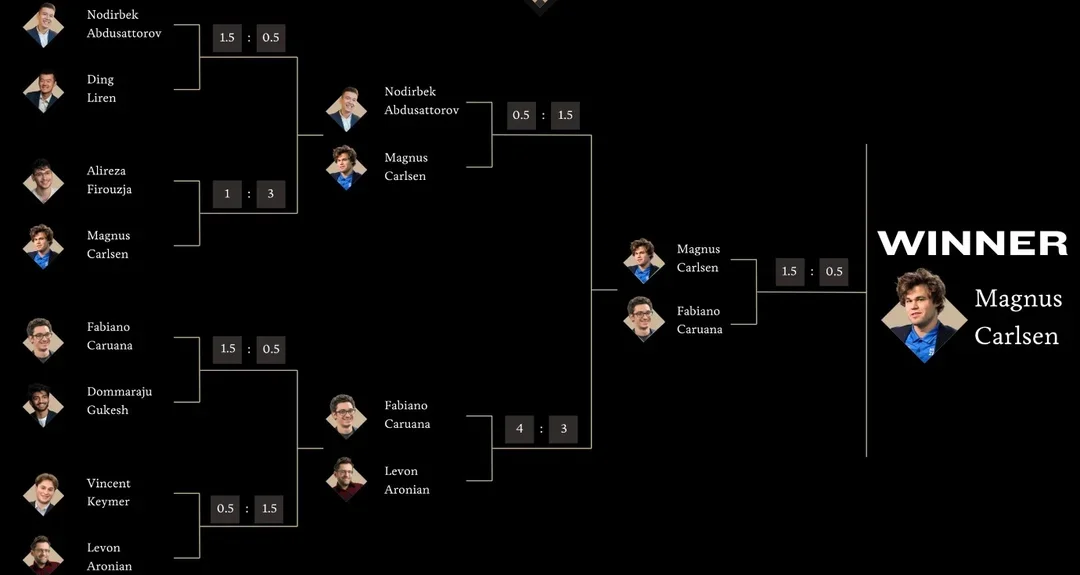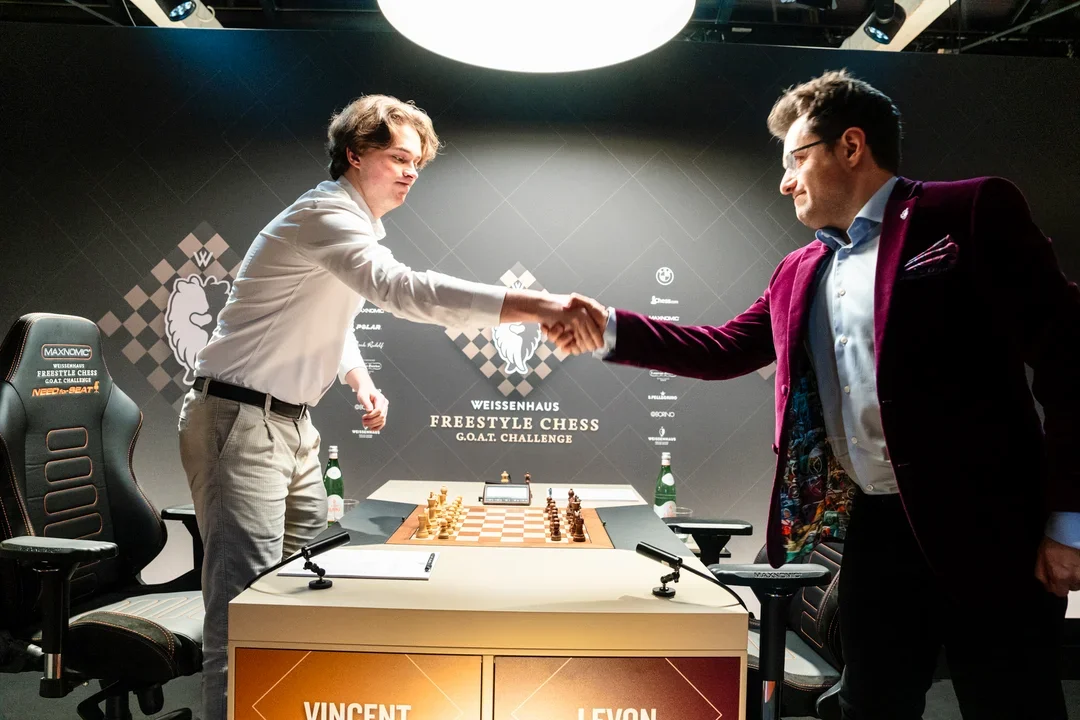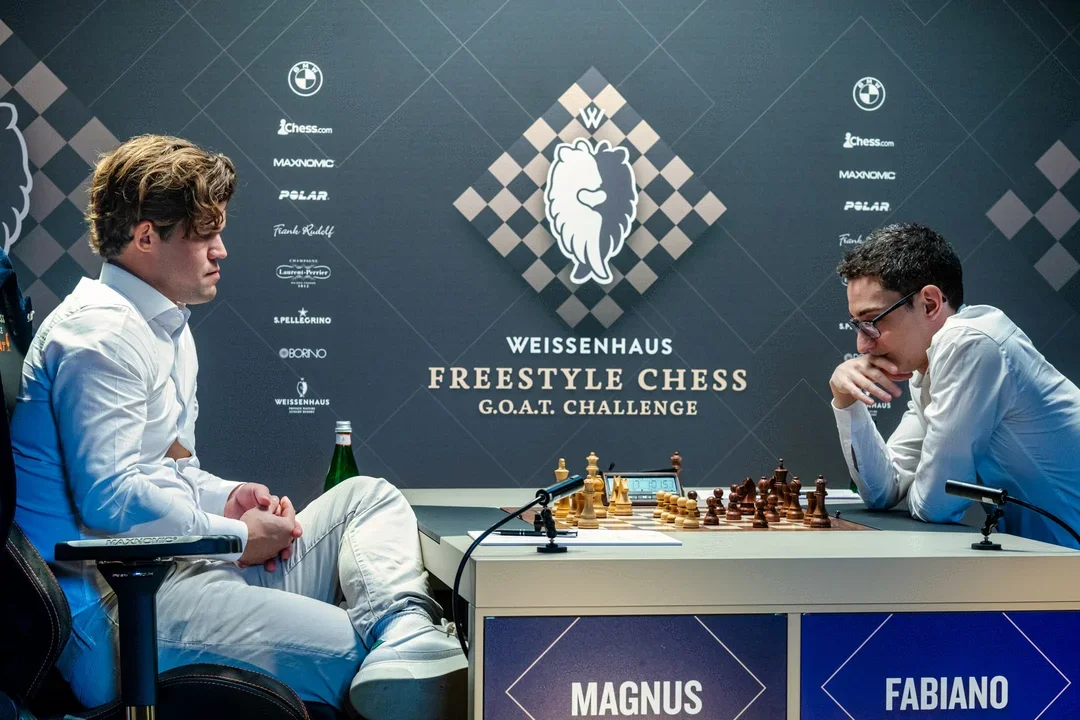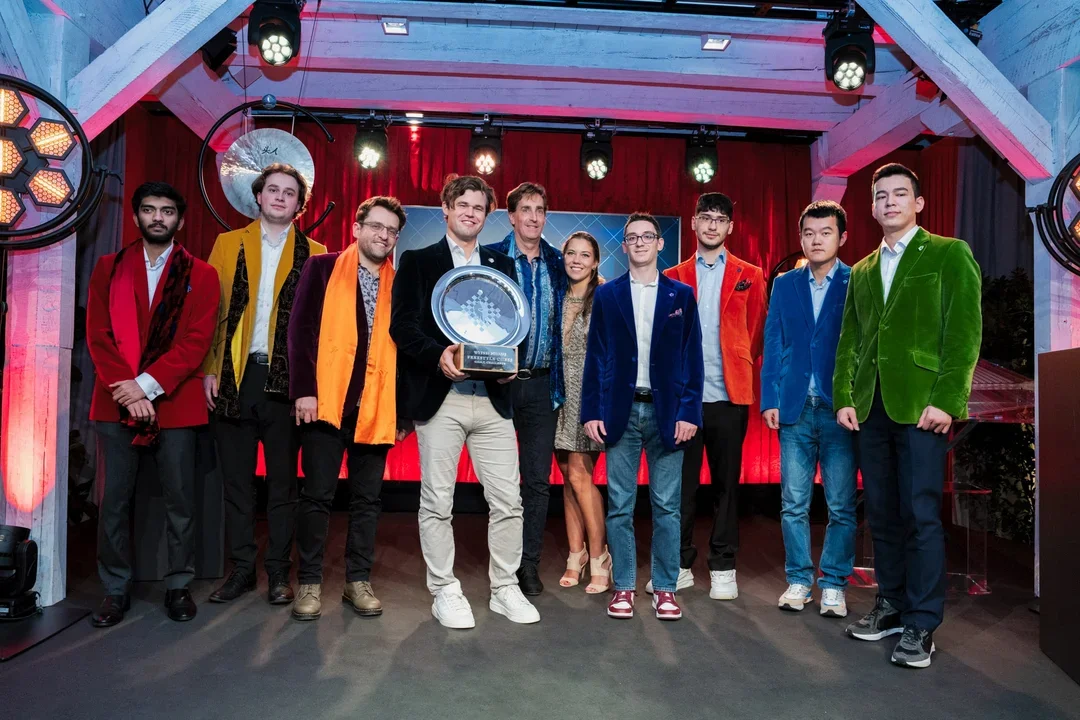While “Freestyle” chess, under one name or another, has enjoyed several marquee events featuring top grandmasters over the past few years, the Freestyle G.O.A.T. Challenge promised something new: fresh positions at a classical time control.
After two days of preliminary rapid games determined the seeding order for the knock-out format, the eight invitees paired off for head-to-head matches at a classical pace (with rapid and blitz tiebreaks, if necessary).

Top-seeded GM Nodirbek Abdusattorov took care of business against a struggling classical world champion in their quarterfinal match, winning the first game with relative ease in the type of positional grind that would have suited a more in-form Ding.
While GM Levon Aronian finished next-to-last to earn the seventh seed in the knockout portion, he “woke up” in his match against second-seeded GM Vincent Keymer, winning 1½–½ thanks to a lovely miniature.

Third-seeded GM Fabiano Caruana also won his match 1½–½, winning with the white pieces against GM Gukesh D. Throughout the event, though, Caruana struggled to get as much out of his openings with the white pieces as several of his peers, including in this come-from-behind win.
All eyes were on the “four-versus-five” match between Carlsen and GM Alireza Firouzja, which was the only match to require a playoff. Similarly to their last online encounter, Firouzja stormed out to an early lead only for Carlsen to even the score and dominate the final phase. Firouzja’s first win, though, was especially nice, as it saw him outplay the former champ in a rook endgame.

Magnus replied in typical fashion in his turn with the white pieces, grinding out an abstract but steady positional advantage without needing any obvious errors from Firouzja to convert.
The first rapid game was headed towards a draw until Carlsen restored the natural order, squeezing water from stone in an equal endgame.
But even though Carlsen seemed in control of the second rapid playoff game, both players found themselves under a minute in a complicated position where three results were possible, with Carlsen eventually emerging victorious.
The format of the tournament was not, strictly speaking, a knockout, as the losers of each match still competed in subsequent matches to determine the order of places five through eight. Firouzja indeed finished fifth, ahead of Gukesh, Keymer, and Ding, respectively.
In the semifinals, Carlsen extracted revenge against Abdusattorov, winning their match 1½–½ in a particularly “freestyle” position where Carlsen’s knight pair proved dominant over Abdusattorov’s measly pair of bishops.
The Caruana – Aronian match turned out to be the pinnacle of drama, however, with Caruana eventually winning 4–3 in the only match to require blitz playoffs. Aronian came out sharp in the first game, thoroughly outplaying Caruana, only to struggle in the return game to ever untangle his pieces out of the opening.
The set of rapid games followed the same pattern, again illustrating the “luck of the draw” with different starting positions chosen for each game and many of them proving quite difficult to defend with the black pieces.
After splitting the pair of blitz games, Black finally came through in an Armageddon game that was easily one of the most complex of the whole tournament.
The finals were then set, with Carlsen having the black pieces first against Caruana.

Unfortunately for the American, he ended up with one of the more tame starting positions, and was unable to get anything out of Carlsen.
In contrast, Magnus had a particularly unique and imbalanced position in their second game, choosing between castling long on move one and pushing the g-pawn on his first turn. He eventually pushed the g-pawn first and had to settle for castling “late” on move two.
Information on how the $200,000 prize fund was distributed is available here. Overall, the event demonstrated that this variant could not only attract a wide audience, but actually hold its attention over the course of eight days, even at a slower time control. Organizer and host Jan Henric Buettner announced that he hopes to expand on this format to create a five-continent tour.

The champion was also pleased, describing the tournament as a “dream come true” for him. Perhaps he should dream bigger, though, as Buettner is already discussing quintupling the prize fund for each tournament in the future!
Categories
Archives
- January 2026 (3)
- December 2025 (27)
- November 2025 (29)
- October 2025 (39)
- September 2025 (27)
- August 2025 (29)
- July 2025 (43)
- June 2025 (25)
- May 2025 (24)
- April 2025 (29)
- March 2025 (29)
- February 2025 (20)
- January 2025 (24)
- December 2024 (34)
- November 2024 (18)
- October 2024 (35)
- September 2024 (23)
- August 2024 (27)
- July 2024 (44)
- June 2024 (27)
- May 2024 (31)
- April 2024 (51)
- March 2024 (34)
- February 2024 (25)
- January 2024 (26)
- December 2023 (29)
- November 2023 (26)
- October 2023 (37)
- September 2023 (27)
- August 2023 (37)
- July 2023 (47)
- June 2023 (33)
- May 2023 (37)
- April 2023 (45)
- March 2023 (37)
- February 2023 (28)
- January 2023 (31)
- December 2022 (23)
- November 2022 (32)
- October 2022 (31)
- September 2022 (19)
- August 2022 (39)
- July 2022 (32)
- June 2022 (35)
- May 2022 (21)
- April 2022 (31)
- March 2022 (33)
- February 2022 (21)
- January 2022 (27)
- December 2021 (36)
- November 2021 (34)
- October 2021 (25)
- September 2021 (25)
- August 2021 (41)
- July 2021 (36)
- June 2021 (29)
- May 2021 (29)
- April 2021 (31)
- March 2021 (33)
- February 2021 (28)
- January 2021 (29)
- December 2020 (38)
- November 2020 (40)
- October 2020 (41)
- September 2020 (35)
- August 2020 (38)
- July 2020 (36)
- June 2020 (46)
- May 2020 (42)
- April 2020 (37)
- March 2020 (60)
- February 2020 (38)
- January 2020 (45)
- December 2019 (34)
- November 2019 (35)
- October 2019 (42)
- September 2019 (45)
- August 2019 (56)
- July 2019 (44)
- June 2019 (35)
- May 2019 (40)
- April 2019 (48)
- March 2019 (61)
- February 2019 (39)
- January 2019 (30)
- December 2018 (29)
- November 2018 (51)
- October 2018 (45)
- September 2018 (29)
- August 2018 (49)
- July 2018 (35)
- June 2018 (31)
- May 2018 (39)
- April 2018 (31)
- March 2018 (26)
- February 2018 (33)
- January 2018 (30)
- December 2017 (26)
- November 2017 (24)
- October 2017 (30)
- September 2017 (30)
- August 2017 (31)
- July 2017 (28)
- June 2017 (32)
- May 2017 (26)
- April 2017 (37)
- March 2017 (28)
- February 2017 (30)
- January 2017 (27)
- December 2016 (29)
- November 2016 (24)
- October 2016 (32)
- September 2016 (31)
- August 2016 (27)
- July 2016 (24)
- June 2016 (26)
- May 2016 (19)
- April 2016 (30)
- March 2016 (36)
- February 2016 (28)
- January 2016 (32)
- December 2015 (26)
- November 2015 (23)
- October 2015 (16)
- September 2015 (28)
- August 2015 (28)
- July 2015 (6)
- June 2015 (1)
- May 2015 (2)
- April 2015 (1)
- February 2015 (3)
- January 2015 (1)
- December 2014 (1)
- July 2010 (1)
- October 1991 (1)
- August 1989 (1)
- January 1988 (1)
- December 1983 (1)







